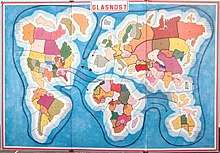Glasnost The Game
Glasnost The Game is a strategic board game, produced by the Cypriot company YL Games. It was invented in 1989 by neuroscientist Yiannis Laouris, with help and inspiration from his daughter Romina, and his friend George Vakanas in Tucson, Arizona. Glasnost The Game is a turn-based game for ideally four players.
 Board of the game | |
| Publisher(s) | YL Games Ltd. |
|---|---|
| Players | 4 |
| Setup time | 5–15 minutes |
| Playing time | 3 to 6 hours |
| Random chance | High (1 dice, 36 cards, squares along a path) |
| Skill(s) required | Military tactics, Strategy, and Negotiation |
It is played on a board depicting a partly modified political map of the Earth, divided into territories, which are grouped into seven continents. The continents are surrounded by a path along which the token-ships of the players move. The Players move their tokens with the classical throw of dice. Players attempt to colonize bordering territories from other players. Once a player owns a territory, they may construct industries. In every round, their industries produce weapons for new armies, which eventually facilitate a player’s ability to make war and conquer new territories (again with the throw of dice). At any time, a player may unilaterally disarm any country that belongs to them. The winner is the player who has the most points when the whole world is disarmed.
Equipment
Each Glasnost The Game game comes with a Board, one die, 36 cards and a number of differently colored tokens denoting armies and industries: Armies are dark, industries are light colored. Both types of token come in the following numbers and denominations: 25x1, 20x2, 5x2, 5x10, 5x20
Description of the Game
The game is played on a board depicting a partly modified political map of the Earth, divided into 166 territories, which are grouped into five continents. Players begin with ownership of 25 industries and 25 armies. Industries represent economic power. Armies are used to colonize/capture adjacent countries or to apply political pressure in order to achieve disarming. Players attempt to colonize territories from other players. Once a player owes a territory, they may build industries inside that territory. In every round, industries produce armies, which eventually assist a player’s capacity to make wars and colonize territories. The ultimate goal of the game is to disarm the Earth. During the process of disarming, players earn credits. At any time, a player may unilaterally disarm any country that belongs to them. When the whole Earth becomes demilitarized, the winner of the game is the player who earned the most points. Demilitarization is the only way to earn points. In the process of the game, it is necessary to negotiate disarming, colonize new countries and make wars with opponents. The game develops players’ abilities to conceptualize, evaluate and implement strategies of cooperation and aggression.
The basic principles include:
- Declaring war is the only way to colonize a territory
- Nobody may ever attack a demilitarized country.
- Disarming a country is irreversible and is the only way to earn points.
A successful implementation of the game takes players from a phase in which aggression and war is required in order to achieve greater control on Earth, to a phase in which players compete in disarming countries. The name denotes the theoretical impossibility of achieving a state of worldwide peace without going through the devastating experiences of war.
History
The inventor witnessed the effects of Cold War while he was studying medicine in Leipzig, then East Germany, when the country was communist. The inventor moved to Göttingen, then West Germany at the time when Mikhail Gorbachev published his Peristroika and Glasnost books. While watching deadly wars in the news, and playing board games like Anti-Monopoly and Risk with his 7-year-old daughter, she was annoyed by the suffering of people all over the planet, and she expressed a wish to “demilitarize” the earth. As the father used the word “glasnost”, to explain the impossibility of a world without armies, she suggested the creation of a game that begins with wars and armies and the winner would be the player who manages to get rid of them.
Various newspapers covered Glasnost The Game publication.[1][2][3]
Newspaper articles on its release
- Fileleftheros Newspaper (Greek name = Εφημερίδα Φιλελεύθερος) . Glasnost also as a Game now: Creator a Cypriot professor researcher (Greek = Τώρα και παιχνίδι η Γκλάσνοστ: Δημιουργός του Κύπριος καθηγητής ερευνητής), 23 December 1989.
- Xaravgi Newspaper (Greek name = Εφημερίδα Χαραυγή). Glasnost, a new youth game (Greek = Γκλάσνοστ, ένα νέο παιδικό παιχνίδι), 29 December 1989.
- Alithia Newspaper (Greek name = Εφημερίδα Αλήθεια). Glasnost the Game of Transparency (Greek = Γκλάσνοστ το παιχνίδι της διαφάνειας ), 16 January 1990.
- Eleftherotypia Newspaper (Greek name = Εφημερίδα Ελευθεροτυπία). Glasnost makes it to children's games; Pioneering contribution of two Cypriots in the international marker place (Greek = Γκλάσνοστ και στα παιδικά παιχνίδια, Πρωτοποριακή προσφορά δύο Κυπρίων στην παγκόσμια αγορά), December, 1989.
- The Cyprus Weekly (Newspaper). Christmas Shopping – the profit and the loss, by Annie Charalambous, pg 23, Dec 22-28, 1989.
References
- "Now also game called Glasnost, article published in Fileleftheros -Cyprus' major newspaper (article in Greek)". Archived from the original on 2011-07-11. Retrieved 2011-03-27.
- "The Game of "transparency" in Alitheia newspaper (article in Greek)". Archived from the original on 2011-07-11. Retrieved 2011-03-27.
- ""Glasnost, a new game for children" in newspaper Xaravgi (article in Greek)". Archived from the original on 2011-07-11. Retrieved 2011-03-27.